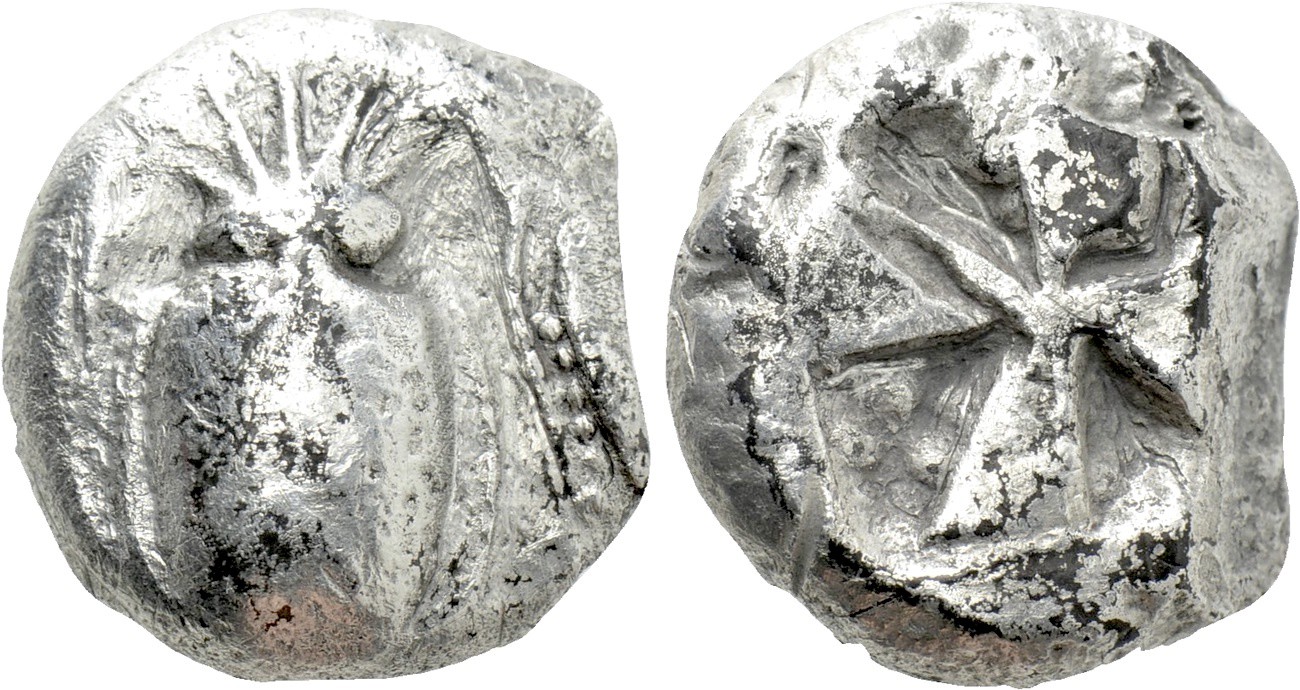S 173 - Coressia, silver, staters (520-480 BCE)
From SILVER
520 BCE - 480 BCE Silver 2,704 kg
Description
| ObverseInscription or printing placed on the obverse.: | Cuttlefish |
| ReverseInscription or printing placed on the reverse.: | Incuse square of "Union Jack" pattern with eight segments |
Mint and issuing power
| MintIdentifies the place of manufacture or issue of a numismatic object.: | Coressia | Ancient regionAncient region.: | Cyclades | Modern countryModern country: Greece | AuthorityIdentifies the issuing power. The authority can be "pretended" when the name or the portrait of X is on the coin but he/she was not the issuing power. It can also be "uncertain" when there is no mention of X on the coin but he/she was the issuing power according to the historical sources: |
Chronology
| FromIdentifies the initial date in a range assigned in a numismatic context. | 520 BCE | toIdentifies the final date in a range assigned in a numismatic context.. | 480 BCE | PeriodTime period of the numismatic object.: Archaic until 480 BC |
Physical description
| MetalThe physical material (usually metal) from which an object is made.: | Silver |
Median weightMedian of the weights of numismatic objects (in grams). in grams | 11.90 | DenominationTerm indicating the value of a numismatic object. Examples: tetradrachm, chalkous, denarius.: | stater |
StandardStandard.: |
Image

S173 Coressus stater.jpg [1]
References
| Die study referencePublication of the study: | Papageorgiadou-Banis 19971Papageorgiadou-Banis 1997, p. 77, n° 1-2, 5-14, Sheedy 20062Sheedy 2006, p. 164, no. 1-3. | ||
| Coin series referenceReference to coin series study: | Sear I3Sear I, n° 3082, HGC 64HGC 6, n° 159 | ||
| Coin series web referenceCoin series web references: | |||
Obverse dies distribution
Reverse dies distribution
no distribution is available
Quantification
| Number of obversesNumber of obverse dies. ᵖ (o) | 7 | Number of singletons (o1)The number of singleton coins. ᵖ | 5 |
| Number of reverse diesNumber of reverse dies. (r) | 12 | Number of coinsNumber of coins. (n) | 14 |
| Coins per obverse dieNumber of coins per obverse die. (n/o) | 2 | Coins per reverse dieNumber of coins per reverse die. (n/r) | 1.17 |
| Reverse per obverse ratioRatio of obverse dies divided by reverse dies. (r/o) | 1.71 | Percentage of singletons (o1)number of coins (n) divided by the number of singletons (o1) ᵖ | 71.43 % |
| Original number of dies (O) (Carter 1983 formula)The estimation of the number of coins according to Carter 1983 ᵖ | 11.36 | Coins struck if 20,000 as average productivity per dieCoins made if the average productivity for obverses (according to Carter) is 20,000. ᵖ | 227,200 |
| Original number of dies (O) (Esty 2011 formula)The estimation of the number of coins according to the singleton formula in Esty 2011 ᵖ (O) | 14 | Survival rate if 20,000 as average productivity per dieSurvival rate if average productivity is 20,000. ᵖ | 0.00006 |
| Coverage (o = % of O) (Esty 1984 formula)Esty 1984 - coverage (% of O) ᵖ (o = % of O) | 64.29% | Die productivity if survival rate 1/2,000Average productivity if survival rate is 1/2,000. ᵖ | 2,464.79 |
| Weight of silver (in kg) if 20,000 coins per die (O = Carter formula)Carter 1983 * Median weight * 20000 (*10 if gold or electrum) ᵖ | 2,704 kg <br /> 2,704 kg | Die productivity if survival rate 1/5,000Average productivity if survival rate is 1/5,000. ᵖ | 6,161.97 |
Remarks
Papageorgiadou-Banis 1997: 14 coins, 7 obv., 12 rev.